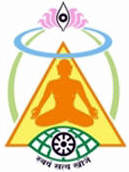
Kayotsarg
Kayotsarg means relaxation of the body with full awareness. According to Lord Mahavir 'relaxation relieves one from all sorrow.' Modern era has termed kayotsarg as relaxation. Relaxation is the process of awakening the consciousness and relieving oneself from stresses. The first step in Preksha Meditation is relaxation, through which the stability of body is achieved. In this practice, the muscles are relieved from stress and relaxed by autosuggestion.
The practice of relaxation also constitutes the foundation for anupreksha (contemplation) and meditation. These are two important way of bringing about a change in life. Unless one practice kayotsarg along with the exercise of Anupreksha and meditation one doesn’t prove to be effective.
Objectives
The main objectives of relaxation are:
- To realize that the soul and the body are two different entities
- To reduce physical inertia
- To acuminate intelligence
- To develop the aptitude of enduring pain and pleasure with equanimity
- To observe the subtleties of our inner body,
- To gain control over our emotions
All these factors play an important role in the spiritual life and are of utmost importance for a Sadhak, a practitioner. A monk is required to perform relaxation whenever he returns from a visit and also in the event of an unusual dream. In addition, any one who achieves these goals is sure to succeed in life.
Technique
There are four stages of kayotsarg:
- Stability of body
- Relief from all kinds of tension
- Abandoning the gross body and coming closer to the subtle one.
- Realizing the detachment of soul from the body. Realizing that the soul and the body are two different entities.
Relaxation can be performed in any of the three postures i.e.
- Standing
- Sitting
- Lying down
For relaxation, select a quiet, clean and pleasant place. Those who are young and strong can do relaxation in standing posture. Those who are relatively aged and weak can choose either a sitting or a lying down posture.
In any of these postures, the body is to be kept calm and stable. The neck, spine/vertebral column, and waist should be erect and straight but without stiffness, and entire body should be left loose. Now simply focusing on each and every part of the body experience relaxation through autosuggestion. Relaxation is very useful in relieving oneself from tensions or anxiety. Half an hour of relaxation can be equivalent to and even more effective in providing rest to the body than two hours of sleep.
Relaxation can be practiced for a long time in continuity or even with breaks in between. In order to achieve different effects, one can practice it at different time.
Durations
For physical and mental health perform relaxation for 20 seconds to 5 minutes, several times a day.
Begin any work with 2 minutes practice of relaxation.
- After finishing any work practice relaxation for 20 minutes
- For emotional well being practice relaxation for 45 minutes, every day before lunch.
Benefits of kayotsarg
- Relieves oneself from physical, mental, and emotional stress
- Soothes the nervous system
- Decelerates the rate of metabolism, breathing, and heartbeats
- Increases the operational efficiency
- Solves the problem of insomnia
- Helps a person to remain calm and peaceful under any situation
- Positive changes in the bio-electrical activities of the brain
- Alertness sharpens the intellect and concentration is achieved
- Constant self-awareness leads to self-realization
Conclusion
It has been pointed out that if a person learns and practice kayotsarg and perform the exercise at least for half an hour everyday, he will remains free from tension under all circumstances. Hence kayotsarg helps a men to get into the depth of consciousness.
 Sadhvi Vishrut Vibha
Sadhvi Vishrut Vibha

